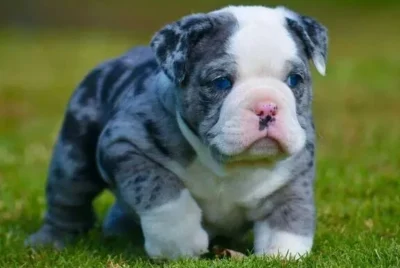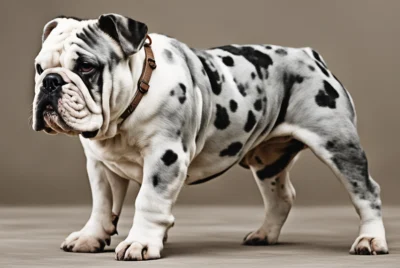10 Things They Don’t Tell You About Merle English Bulldogs
Finding the perfect pet isn’t just about looks. Merle English Bulldogs may have captured your heart with their unique coat and charm, but there’s more beneath the surface. The internet and breeders often omit critical facts about this breed.
That’s why I’ve created this guide to reveal the truth about owning these adorable dogs. Being well-informed is the first step towards responsible pet ownership. Prepare for some surprises and take this essential step towards understanding your potential furry friend better.
What Is A Merle English Bulldog?
Merle English Bulldogs are quite the visual spectacle in the canine world, admired for their captivating, unusual coat. The term “Merle” is not a breed identifier but instead a descriptor for a specific coat pattern seen in various dog breeds, including English Bulldogs.
This Merle pattern, often described as a coat that looks like a splotch painting or your favorite cookies-and-cream ice cream, consists of a mottled patchwork of colors. It’s caused by a specific gene that alters the pigmentation.
The result? A base coat, usually white or light-colored, splashed with patches or spots of another color. The spots can be blue, gray, tan, or black – leading to descriptors like “blue Merle” for grayish-blue markings.
But remember, the Merle pattern is more than a striking coat. It’s a marker of the unique genetic diversity of these dogs. So, a Merle English Bulldog is still an English Bulldog – just one with an uncommon, eye-catching appearance thanks to its distinctive coat. Despite their coat differences, they share the same loveable, tenacious, and friendly temperament typical of English Bulldogs.

Types of Merle English Bulldogs
- Blue Merle English Bulldog: This type exhibits a blue or grayish coat with patches or marbling of darker shades. The blue Merle pattern is quite distinct and gives the dog a unique appearance.
- Lilac Merle English Bulldog: This bulldog has a coat that displays a diluted chocolate color with a Merle pattern. This results in a beautiful blend of lilac and Merle markings.
- Tri Merle English Bulldog: It showcases three colors in its coat, typically including a Merle pattern combined with patches of black, tan, or white. This combination creates a striking and vibrant appearance.
- Chocolate Merle English Bulldog: This type has a chocolate-colored coat with a Merle pattern overlay. The chocolate Merle Bulldogs have a rich and deep brown coat, enhanced by the distinctive Merle markings.
- Black Merle English Bulldog: It has a black coat with Merle markings. The Merle pattern may include shades of gray or silver mixed with black, creating a visually captivating effect.
- Tweed Merle English Bulldog: This bulldog showcases a unique and rare coat pattern. It combines the Merle pattern with brindle markings, resulting in a mottled and intricate appearance resembling the texture of tweed fabric.
- Ghost Merle English Bulldog: This bulldog is has lighter, more subtle Merle pattern. The coat may display softer shades such as pale gray, silver, or cream, creating a ghostly or ethereal appearance.
- Double Merle English Bulldog: This bulldog has inherited the Merle gene from both parents. They usually have a predominantly white coat with patches of Merle color. Double Merle Bulldogs can have a higher risk of certain health issues associated with the double Merle gene.
1. Are Merle English Bulldogs Recognized By The AKC?
While Merle English Bulldogs certainly possess a unique beauty, it’s essential to know that they are not recognized by the American Kennel Club (AKC). Other English Bulldog breed clubs also generally do not accept them. This is because the Merle coloring does not align with the breed standard, which outlines the characteristics that define each breed.
A significant reason for this lack of recognition is that the Merle gene does not naturally occur in English Bulldogs. It’s introduced through crossbreeding with other Merle-carrying breeds, which can lead to a divergence from the traditional English Bulldog characteristics.
Another crucial reason is the health issues associated with the Merle gene. The same gene that gives these Bulldogs their distinctive coat can also lead to various health complications, including vision and hearing problems.
2. Are English Bulldogs Merle Good Family Dogs?
Yes, Merle Bulldogs can indeed be good family dogs. They possess a gentle, sociable, and affectionate nature that makes them well-suited for family life.
They generally get along well with children. While they may display some stubbornness during training, they are generally easy-going and can also serve as reliable watchdogs due to their alertness.
However, it’s important to be aware of the potential health issues of Merle gene and to source Merle Bulldogs from responsible breeders who prioritize the health and well-being of their dogs. You must prepare for potential health challenges and provide proper care and attention to help ensure a positive family experience with a Merle Bulldog.
3. The Health of Merle Bulldogs
The health of Merle Bulldogs can be a matter of concern due to the Merle gene. While this gene gives them their distinctive coat color, it can also cause health issues. The Merle gene is linked to a range of sensory deficits, including vision and hearing problems. It can also lead to other health complications.
However, not all Merle Bulldogs will experience these issues. It’s crucial to note that individual health can vary widely within a breed due to various factors, including genetics and care. Therefore, potential owners should work with reputable breeders who conduct thorough health screenings and prioritize the overall health and well-being of their dogs.

4. Is A Merle English Bulldog A Special Breed?
No, a Merle English Bulldog is not a special breed. The term “Merle” refers to a specific pattern and coloration of the coat, not the breed of the dog itself. They are still English Bulldogs; they just have a unique coat pattern due to the presence of the Merle gene.
This pattern is often marked by patches of diluted color on a lighter coat. Despite their different appearances, they share the same breed characteristics and traits as standard English Bulldogs.
5. Are Merle English Bulldogs Rare?
Merle English Bulldogs are more than those with more common coat colors. This rarity is largely due to the Merle gene being recessive, which makes it less common in the population.
Additionally, responsible breeders often avoid breeding Merle dogs together due to potential health issues associated with the Merle gene, including visual and auditory problems. Consequently, while their unique coat can be visually striking, they are indeed relatively rare.
6. The Size of a Fully Grown English Bulldog Merle Get
When fully grown, Merle Bulldogs generally reach a height of around 14 to 15 inches (35 to 38 centimeters) at the shoulder. In terms of weight, adult males typically weigh around 50 pounds (23 kilograms), while adult females tend to weigh around 40 pounds (18 kilograms).
These weight and height ranges are approximate averages and can vary slightly depending on individual genetics and other factors. It’s important to note that proper nutrition, exercise, and overall care can contribute to a Merle Bulldog reaching their full potential size.
7. Can Two English Bulldogs Merle Engage In Breeding?
While two Merle dogs can physically breed, it is strongly discouraged due to the potential health risks for the puppies. Breeding two Merle dogs together can lead to what’s known as “double Merle” offspring, which carry two copies of the Merle gene.
Double Merles are at a significantly higher risk of having health problems, including severe visual and auditory impairments, due to the intensified effect of the Merle gene. Responsible breeders avoid breeding two Merles together to prevent these potential health issues.
8. Why Are Merle English Bulldogs So Expensive?
Merle English Bulldogs are typically more expensive than other English Bulldogs due to their rarity, breeding complexities, unique appearance, and potential health care needs. The Merle gene, which gives these Bulldogs their distinctive coat, is less common and therefore makes these dogs rarer.
Responsible breeding requires careful tracking of lineage to avoid potential health issues linked to the Merle gene, adding to the cost. Additionally, their unique, striking appearance can make them highly sought after, driving up the price.
Also, the potential health issues connected to the Merle gene might necessitate more health screenings and veterinary care, further increasing the overall cost.

9. How Much Does a Merle English Bulldog Cost?
The cost of a Merle English Bulldog can vary widely based on several factors, including the breeder’s reputation, the dog’s coat color, and rarity. On average, you can expect to pay anywhere between $4,500 and $15,000 for a Merle English Bulldog puppy from a reputable breeder.
However, in some cases, the price may even exceed $15,000, particularly if the breeder is highly regarded and the dog has a unique or highly sought-after coat color. As with any significant investment, prospective owners should thoroughly research and select a responsible breeder who prioritizes the health and well-being of their dogs.
10. Merle English Bulldogs Cannot Be Owned By Anyone
Merle Bulldogs can be owned by individuals who are committed to providing responsible care and are knowledgeable about the potential health risks associated with the Merle gene. However, it’s essential to note that owning a Merle Bulldog requires a higher level of understanding and dedication compared to owning a Bulldog with a more typical coat color.
Prospective owners should educate themselves about the specific care requirements, potential health issues, and responsible breeding practices associated with Merle Bulldogs. Additionally, they should be prepared for potential health care costs and be willing to provide the necessary attention, socialization, and training required for a happy and healthy Merle Bulldog.
Final Thoughts: Should You Get a Merle English Bulldog?
When considering whether to get Merle English Bulldogs, there are important factors to weigh. While they can be visually striking and have unique personalities, potential owners should be aware of the potential health risks associated with the Merle gene.
Finding a reputable breeder who prioritizes health screenings and responsible breeding practices is crucial. Additionally, owning a Merle Bulldog requires commitment to their care, including socialization, training, and providing necessary veterinary attention.
By considering these factors and making an informed decision, prospective owners can determine if a Merle Bulldog is the right fit for their lifestyle and can provide the necessary care and attention these dogs deserve.




